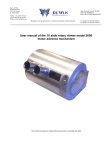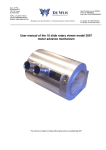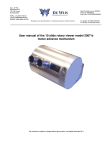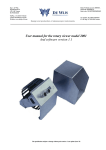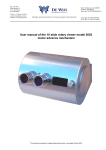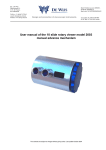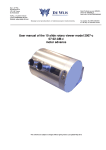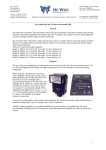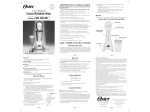Download 04-01-A-x user manual UK
Transcript
Bank: Postbank account: 6084601, Swiftcode: INGBNL2A Bank code: NL24PSTB0006084601 Ing. J. de Wijs. Populierstraat 44, 4131 AR Vianen, the Netherlands Tel/Fax. +31 (0)347-372242 e-mail: [email protected] Website: www.dewijs-3d.com Tax number: NL 1899.16.084 B01 K.v.K. Reg. Nº 23071201 Utrecht Design and production of stereoscopic instruments. User manual for the rotary viewer model 2004 The specification subject to change without prior notices. Last update July 2005 Contents INTRODUCTION ..................................................................................... 3 1. 1.1 1.2 1.3 2. 2.1 2.2 DIRECTIONS FOR TAKING INTO OPERATION ...................... 4 OPENING THE VIEWER (WITH WOODEN COVER). ................................................... 4 WHERE DO I PLACE THE VIEWER? ..................................................................... 4 HOW CAN I MOUNT THE VIEWER? ...................................................................... 4 MANUAL OPERATION (WITHOUT PC CONTROL)................. 5 INSERTING SLIDES: .......................................................................................... 5 SELECTING FUNCTION MODES ........................................................................... 6 3. CONNECTION DIAGRAM.............................................................. 7 4. EXTERNAL CONTROL (WITH PC).............................................. 8 5. MAINTENANCE ............................................................................... 9 5.1 5.2 5.3 5.4 6. 6.1 6.3 6.4 6.5 6.6 CLEANING SLIDES............................................................................................ 9 CHANGING THE LAMP ...................................................................................... 9 CLEANING / EXCHANGING THE LENSES. ............................................................ 10 SOLVING MISS-ALIGNMENT. ............................................................................ 11 TECHNICAL DATA ....................................................................... 12 SIZES AND DIMENSIONS .................................................................................. 12 CONNECTIONS OF THE D25 AND D15 CONNECTORS. ................................................. 13 CABLING INSIDE THE ROTARY VIEWER.............................................................. 14 ELECTRONIC SCHEMATICS ................................................................................... 15 ELECTRONIC COMPONENT LIST............................................................................. 16 Introduction This rotary viewer is a result of 30 years experience building public stereo slide viewing equipment. Every model had its improvements with regards to previous models meaning durability, stability and quality. This latest model has been build using the latest CAD-CAM techniques and production techniques. To give an idea of the changes to this model; - The supporting frame for the drum and lens barrels is now casted, giving more stability and better alignment of the drum. - The electronics are now running on 12 Volts dc. For more safety and less dependent on the local mains voltages using an adapter. - Illumination by Cold Cathode Fluorescent Lamp (CCFL). - Improved motor spanner. - Easier adjustment of misalignment of the drum. - Easier removal of the front panel from the supporting frame. - Two choices of appearance; as build-in-wall version and as stand alone with wooden cover version. 1. Directions for taking into operation 1.1 Opening the viewer (with wooden cover). Disconnect all cables from the viewer at the back. Remove the 2 bolts on top of the viewer mounted in the tilted front panel. Unlock the lock at the front. Now grab the lens tubes, pull on these lenses upwards. This should release the mechanical construction from the cover. Pull the total mechanical construction out of the casing and place it on a flat solid table. Now you should be able to change slides, remove dust, etc. 1.2 Where do I place the viewer? Obviously you already have chosen a spot for the viewer in your museum, exhibition or other public environment. Here are some considerations that might help you to check the spot; ? ? Keep in mind the height of the viewer. Children and grown-ups both want to look in the viewer! ? ? Depending on the interest of the viewer, people might form a queue. This could cause congestion for the rest of the public. ? ? Watch out for sunlight coming through the lenses! The lenses will act like burn glasses on the slides. A few minutes in the sun will cause enough damage to the slide that it should be replaced. Within 1 day, in worst case, you have to replace all slides. You can see this on the slide like tiny little white spots showing the track of the sun during the day. ? ? Avoid spotlights to be shinning on the lenses. The slides are not going to be burned but it does shorten the lifecycle of the slide. ? ? Cover the back opening of the viewer with all its connectors and cables. Avoid the public to get access to this part of the viewer. Let the installation of the electrical cables be executed by authorised personal only. ? ? Do always provide a grounding facility to the casing of the viewer. By default the Euro connector provides a solid Earth connection. ? ? When the viewer is to be mounted inside some kind of panel, be sure you can get easy access to the viewer for replacing the lamp bulb and slides. 1.3 How can I mount the viewer? ? ? The rotary viewer can be used hanging on a wall or mounted on a table. The wooden casing should be strong enough to hold screws and bolts. ? ? For temporary exhibitions, it is best to place the viewer on a table without any fixation to the table. Again, when children get access to the viewer, use double-sided tape to fix it to the table. 4 2. Manual operation (without PC control) In this situation, the rotary viewer is used in stand-alone mode, without any external control devices. This mode is also recommended when inserting or changing the slides. 2.1 Inserting slides: Disconnect all cables from the viewer at the back. Remove the mechanical construction as described in chapter 1.1. In the left picture you see how to insert the slides in the drum. With your finger you should keep the spring on its place when shifting the slide. After inserting the slide you have to push the slide inside-out of the drum to get it in focus point. Push with one finger in the middle of the slide frame between the images. 5 2.2 Selecting function modes The rotary viewer is able to work in 4 different modes, in stand-alone situation. These modes are configurable using the small switches at the back of the viewer. The black square marks the position of the switch. Mode 1: After the pre-set shut-off time, the lamp turns off and the viewer stays at this slide. 1 2 3 4 Mode 2: After the pre-set shut-off time, the lamp turns off and the drum revolves to slide number 1. Mode 3: The lamp is always on, after the shut-off time the viewer stays at the current slide. 1 2 3 4 1 2 3 4 Mode 4: The lamp is always on, after the shut-off time the drum revolves to slide number 1. 1 2 3 4 ? ? Connecting the adapter to the corresponding socket can now turn on the rotary viewer. ? ? You can adjust the shut-off time of the lamp by turning with a screwdriver the knob between the two Sub-D sockets at the rear of the viewer. Turning counter counter-clockwise will increase the time, turning clockwise will decrease it. 6 3. Connection diagram SW1: adapter: 12 Volts d.c. 1,5A stabelized SW2: SW3: SW4: updownupdownupdownupdown- lamp turn-off delay active lamp always on front button passes signal to external device. front button directly controls viewer after lamp turns off, nothing happens after lamp turns off, drum goes to slide Nº 1 amplifier turned off amplifier turned on external switch box Viewer control interface Lamp turn-off delay Dutch Enlish German French Language selection box Internal CD-ROM in PC 7 4. External control (with PC) In this situation, the rotary viewer is able to operate according to a configured program with or without audible explanation of the slide. An IBM compatible PC is required to work with the accompanied software of the rotary viewer to control the rotary viewer. Look at www.dewijs-3d.com at the technical information and download pages for more information about this function. 8 5. Maintenance In general does the rotary viewer not need any mechanical maintenance using it on a fixed location and handled with care. The viewer is made quite solid with the aim to guarantee the best optical alignment of the lenses as long as the life cycle of the viewer is. A hard impact at the front, like tumbling from a table, causes inevitable miss-alignment of the drum and maybe bend main axle. So be careful when transporting the viewer and arrange a stable spot to place the viewer. Besides these incidents, the viewer gets covered with a thin layer of dust, outside as well as inside. 5.1 Cleaning slides. Open the viewer according to the actions to be taken in chapter 1.1 You have two types of slide mounts; - mounted in masks and encased in glass. - mounted in frames without glass Encased in glass: In this case you do not have to take the slides out of the drum. Best is to turn the rotary viewer into manual operation (chapter 2.1 mode 2). Take a soft cloth, clean the slide first at the outside of the drum. Secondly clean it at the inside of the drum. When cleaning it push it a little inside out of the drum to preserve fixed focus position of the slide. Without glass: This is a difficult situation. Slide frames without glass are very fragile. Taking them out of the drum, cleaning them, and replace them back again often causes damage to the slide. So if you can, take a soft brush and wipe the dust away at both sides. When the dust is too much, then there is no other way than taking them out of the drum. Try cleaning it with the brush and finally with a soft lens cleaning cloth. Be very careful, some clothes can even scratch the slides, or decreases the clearness. 5.2 Changing the lamp The CCFL lamp has a lifespan of 10.000 hours. If the viewer is used 8 hours a day (lamp turned on) it should take theoretically 3 years before replacing the lamp. But if the brightness is getting too low follow the next instructions. ? ? Open the viewer according to the actions to be taken in chapter 1.1 ? ? At the left side of the frame you can get access to the CCFL lamp holder. First disconnect the cable that runs to the back of the CCFL panel. Then remove the two bolts at the left side of the frame that attaches the lamp to the casted frame. ? ? Now you can take the total CCFL panel with holder out of the viewer and send it to the ‘de Wijs’company for replacing the lamp. 9 5.3 Cleaning / Exchanging the lenses. After several years of use the lenses are scratched and dust is coming between the two achromatic lenses. The lenses are can be taken apart to clean them. Follow the following steps: 1. Open the viewer according to the actions to be taken in chapter 1.1 2. The two lens barrels are screwed in the casted frame and locked with a small M3 bolt on top. First remove this bolt. 3. The barrels are mounted tight in the frame, use some kind of ‘belt’spanner to remove the lens barrels. 4. Now you need to make a small little metal plate of 1 mm. Thickness. With a length of about 60 mm. And exactly 37 mm. Width. 5. Now put the metal plate in the back off the barrel and be sure it fits in the small gaps of the screw ring that keeps the lenses in its barrel as shown in right picture… 6. Turn the metal plate counter clockwise to release the screw. 7. When the screw is released, take a soft cloth and put it with your finger in the back of the lens barrel against the lenses. 8. Turn the total barrel upside down so the lenses will drop out of the barrel. 9. Warning!! The lenses do have a front and backside. The front (view side) is the side with the most flat surface. This counts for both lenses. 10. With a soft clothe and a brush cleans the lenses. Look through the lenses against the light to check cleanliness they might show remaining dust of scratches. 11. If you decide to replace the lenses, you can order them at the De Wijs Company. 12. Put the lenses together and follow the steps (1-10) in reverse. 10 5.4 Solving miss-alignment. Especially during installing the viewer in a public viewing area, parts of the viewer have to be de-assembled. The drum is the most sensitive part to be aligned for the lenses. The axle on which the drum is running can be moved to the front or to the back of the viewer. To make the re-alignment somewhat easier you can check some measurements to get the drum roughly in position, see the picture below. The distance from the centre of the axis to the edge of the milled chamber is 20 mm. This view is seen from the left side of the viewer, that is the side to get access to the CCFL lamp CAUTION: the optical switches, just above the front plate, close to the push button are fragile and need to be handled with care when taking the drum out of the frame or moving it into focus. 11 6. Technical data 6.1 Sizes and dimensions Rotary viewer 2004 model A, for 41x101 mm. Frames ? ? Maximum picture format: 28x33 mm. ? ? Lenses: double coated achromatic ø 37 mm. F= 120 mm. (total 60 mm.) ? ? Maximum amount of slides: 21. ? ? Text card size: ?? General data: ? ? Weight rotary viewer, build in wall version: 11.5 kg. ? ? Weight rotary viewer, with wooden cover. ? ? Illumination: Cold Cathode Fluorescent Lamp of 5500 Kelvin ? ? Power supply: 12 Volts. 0,5 Ampère, Adapter 12 Volts stabilized 1,5 Ampère. ? ? Power consumption: 6 Watt. ? ? The rotary viewer is fused for 1 A slow. ? ? D25 connector providing an interface to an XT/AT parallel port of a computer. ? ? D15 connector providing an additional interface to an external language selection device. ? ? The D15 connector is also providing an external stabilised power supply of +5 and +12 Volts. ? ? Adjustment of the turn-off time of the lamp is possible between 5-70 seconds. ? ? The software that is provided with the rotary viewer is written in Pascal 7.0 and runs on DOS. On almost every x86 machine with CD-ROM player the software will work. A Windows version will be available in the future. 12 6.3 Connections of the D25 and D15 connectors. D25 connector: Connector Description computer side and pin addressing 1 Strobe Base+2 bit 0 2 D0 Base+0 bit 0 3 D1 Base+0 bit 1 4 D2 Base+0 bit 2 5 D3 Base+0 bit 3 6 D4 Base+0 bit 4 7 D5 Base+0 bit 5 8 D6 Base+0 bit 6 9 D7 Base+0 bit 7 10 Acknowledge Base+1 bit 6 11 Busy Base+1 bit 7 12 Paper end Base+1 bit 5 13 Select out Base+1 bit 4 14 Auto feed Base+2 bit 1 15 Error Base+1 bit 3 16 Init Base+2 bit 2 17 Select in Base+2 bit 3 18 Gnd 19 Gnd 20 Gnd 21 Gnd 22 Gnd 23 Gnd 24 Gnd 25 Chassis ground Description rotary viewer side Not used Change slide, 1= moving Lamp, 1=lamp on. Not used Not used Loopthrough to D15 con. Loopthrough to D15 con. Loopthrough to D15 con. Loopthrough to D15 con. Button front panel, 1=pressed Loopthrough to D15 con. Light gate ‘zero’detection. Light gate ‘stop’detection. Not used Loopthrough to D15 con. Not used Not used D15 Connector: (for language selection box) Connector Description computer side and Description rotary viewer pin addressing side 1 Busy Base+1 bit 7 Loopthrough to D25 con. 2 Ground 3 +12 Volt. 4 +5 Volt. 5 D5 Base+0 bit 5 Loopthrough to D25 con. 6 D6 Base+0 bit 6 Loopthrough to D25 con. 7 D7 Base+0 bit 7 Loopthrough to D25 con. 8 Error Base+1 bit 3 Loopthrough to D25 con. 9 D4 Base+0 bit 4 Loopthrough to D25 con. 10 11 12 13 14 15 Direction looking from computer side. Output Output Output Output Output Output Output Output Output Input Output Input Input Output Input Output Output Direction looking from computer side. Input Output Output Output Input Output 13 6.4 Cabling inside the rotary viewer Optical switches Wiring diagram inside rotary viewer blinking LED CCFL tube with diffuser ccfl inverter Front panel button Drum Motor 14 6.5 Electronic schematics 15 6.6 Electronic component list R1 R2 R3 R4 R5 R6 R7 R8 R9 R10 R11 R12 R13 R14 R15 R16 R17 R18 R19 R20 R21 C1 C2 C3 C4 C5 C6 C7 C8 C9 C10 C11 C12 D1 D2 10K 1/4 Watt IR detect 10K 1/4 Watt IR detect 100K 1/4 Watt 10K 1/4 Watt 100K 1/4 Watt 10K 1/4 Watt 10K 1/4 Watt 100K 1/4 Watt 180 1/4 Watt 100 1/4 Watt 100K 1/4 Watt 100K 1/4 Watt 10K 1/4 Watt 10K 1/4 Watt 1M 0.15 Watt 10 mm. standing Pot. 10K 1/4 Watt 100K 1/4 Watt 180 1/4 Watt 100K 1/4 Watt 10K 1/4 Watt 22 1 Watt 47uF 10 Volt axial 100n 50 Volt polyester 4,7uF 50 Volt Elco rad 100n 50 Volt polyester 100n 50 Volt polyester 1000uF 16 Volt Elco rad. 100n 50 Volt polyester 47uF 10 Volt axial 100uF 16 Volt Elco ax. 100n 50 Volt polyester 100n 50 Volt polyester 100n 50 Volt polyester 1N4001 1N4001 D3 T1 T2 T3 T4 T5 U1 U2 U3 U4 1N4001 BC547b BC547b BC547b BC547b BC547b 4081 Quad And Relays 2x 12V OMRON G2R-2 LM555 timer IC Relays 1x 12V OMRON G5V-1 U5 U6 U7 U8 U9 J1 J2 4071 Quad Or LM7805 1A 4049 Hex inv. Buff. LM555 timer IC LM555 timer IC D25 PCB socket 90º male Header 8 pins Header Socket 8 pins J3 D15 PCB socket 90º male J5 Header 2 pins J6 Header 2 pins Header Socket 2 pins Shrink contacts for Headers SW1 Dip switch 4x 90º 3 DIL8 sockets 2 DIL14 sockets 1 DIL16 sockets F1 Fuse holder internal metal clamps 1 Opto switches 5mm. Gap with PCB Wiring to opto coupler and front panel switch 8 leads 74,5 cm. Long Wiring to CCFL tube lamp 45 cm. Wiring to motor; single leads 10 cm. 1 04-01-PCB; circuit board 16

















